Klangkosmos Weltmusik
In 2005 wird die Konzertreihe Klangkosmos Weltmusik in ihr fünftesviertes Jahr gehen!!! Die sechs Konzerte von Januar bis Juni werden Ensembles und Musiktraditionen aus sehr entlegenen Teilen der Welt präsentieren:
27. Januar
18.00 Uhr
Thomaskirche, Opphoferstraße 60
Vache Hovsepyan Duduk Quintett / Armenien
Die Klänge des Aprikosenholzes
18.00 Uhr
Thomaskirche, Opphoferstraße 60
Vache Hovsepyan Duduk Quintett / Armenien
Die Klänge des Aprikosenholzes
Das Vache Hovsepyan Duduk Ensemble wurde im Jahre 2000 gegründet. Das Konzertprogramm des Ensembles zeigt eine Vielzahl armenischer Musikstile. Neben Stücken von bekannten armenischen Komponisten wie Komitas, Kara-Murza und Margar Ekmalyan werden auch zeitgenössische Lieder aufgeführt. Das Duduk, ein Holzblasinstrument ähnlich einer Oboe, ist wohl das traditionellste Instrument Armeniens und blickt auf 3500 bis 4000 Jahre musikalischer Geschichte zurück. Es wird handgefertigt aus Aprikosenholz. Nur wenige Musiker sind mit seiner Spielart vertraut. Es umfasst 1½ Oktaven und erfordert beachtliches Fingerspitzengefühl sowie eine ausgeprägte Atem- und Lippentechnik, um die hohe Bandbreite von Melodien und anhaltenden, lang gezogenen Tönen hervorzubringen. Man sagt dem Duduk nach, dass sich das Befinden der meist armen armenischen Bevölkerung in den Tönen und Klängen widerspiegelt. Die warme Klangfarbe ist fesselnd und die Melodien erreichen die Herzen der Zuhörer.
17. Februar
18.00 Uhr
Alte Kirche Wupperfeld, Bredde 69
Geoff Muldaurer/USA
Folk und Blues der amerikanischen Ostküste
18.00 Uhr
Alte Kirche Wupperfeld, Bredde 69
Geoff Muldaurer/USA
Folk und Blues der amerikanischen Ostküste
Geoff Muldauer ist eine der großen Stimmen aus der Folk- und Bluesszene der amerikanischen Ostküste. Dort entstand in den frühen Sechzigerjahren um die Zentren Cambridge, Massachussetts und Woodstock, New York eine Szene, von der nachhaltige Impulse für die gesamte amerikanische Musik ausgehen sollten. Nicht nur Bob Dylan und Joan Baez, zwei maßgebliche Stimmen der amerikanischen Bürgerrechts- und Protestbewegung, fanden hier ihre künstlerische Heimat. Aus den Wohnzimmern und Coffeehouses dieser Szene wurde ein Folk- und Blues-Repertoire in die Welt getragen, das noch heute Magie und Be-deutung transportiert. Die große Kunst von Geoff Muldaur ist es, tiefe und eindringliche Musik zu kreieren auf eine Art, die an Ursprüngliches rührt und gleichzeitig fast leichtfüßigleichtfüßig daherkommt. Auf leisen Sohlen, mit Sanftheit und Würde. Dabei wird Muldaur nicht zum Kopisten afro-amerikanischer Originale, sondern schafft vor dem Hintergrund Kontext seiner Repertoireauswahl und mit den Möglichkeiten seiner Stimme und seines Gitarrenspiels etwas ganz Eigenes.
10. März
18.00 UhrLutherstift, Schusterstraße 15
Sanam Uighur Ensemble/Usbekistan
Musiktraditionen der Uighuren
18.00 UhrLutherstift, Schusterstraße 15
Sanam Uighur Ensemble/Usbekistan
Musiktraditionen der Uighuren
Die Uighuren sind ein großer Volksstamm turkmenischer Herkunft. Sie leben überwiegend in China und Turkmenistan, jedoch findet man sie auch in Kasachstan, Usbekistan und Kirgisien - Ländern, in die sie während der Sowjet-Ära immigrierten. Ihre Musik ist reich und bemerkenswert. Verwurzelt in der leuchtenden Vergangenheit des Landes und seiner Macht in Kultur und Handel. In der Musik verbinden sich alle Aspekte und Formen der östlichen Musik, vom nouba der andalusischen Araber bis zu chinesischen Harmonien. Musik speziell aus der uighurischen Diaspora Usbekistans ist bisher sehr selten im Ausland aufgeführt worden. Die besonderen Klänge der unterschiedlichsten Varianten von Langhalslaute und Geige, gezupft, geschlagen oder gestrichen und begleitet von Perr-kcussion und Gesang, löst immer große Begeisterung beim Publikum aus.
14. April
18.00 Uhr
Thomaskirche, Opphoferstraße 60
Familia Pillco/Cuzco
Violinen- und Harfenmusik aus den Anden Perus
18.00 Uhr
Thomaskirche, Opphoferstraße 60
Familia Pillco/Cuzco
Violinen- und Harfenmusik aus den Anden Perus
Cuzco in Peru war nicht nur die Hauptstadt der Inkas, sondern nach Jahren des bitteren Kampfes zwischen Pizzaro und der Inka-Armee entstand eine zweite Kultur: die der Mestizen. Das ist die Mischung zwischen den Spaniern und den Ureinwohnern, die nicht nur die Sprache und das Essen, sondern auch die Musik beeinflusst hat. Das zeigt uns das Trio der Familia Pillco. Die Violinen von Reynaldo und Enrique zusammen mit der Harfe von Alejandro Huaman Quispe lassen wunderbare Melodien der Anden erklingen: melancholische Yaravis, fröhliche Huaynos und lebendige Tänze der Küstenregionen. Die zwei Violinen des Vaters Reynaldo und des Sohns Enrique Pillco und die Harfe von Alejandro Huaman Quispe spielen wunderbare Melodien der Anden - lebendige Tänze der Seeleute, melancholische Yaravis, fröhliche Huayanos - populäre Musik der Bachs und Schuberts Lateinamerikas.
26. Mai
18.00 Uhr
Alte Kirche Wupperfeld, Bredde 69
Nahawa Doumbia/Mali
Queen of Didadi
18.00 Uhr
Alte Kirche Wupperfeld, Bredde 69
Nahawa Doumbia/Mali
Queen of Didadi
Nahawa Doumbia ist eine der populärsten Sängerinnen der Wassoulou-Region im Süden von Mali. Diese Region ist seit Generationen bekannt für die besten Sänger des Landes wie Oumou Sangare, Sali Sidibe oder Dieneba Diakité. Nahawa Doumbia spricht mit ihren Songtexten besonders die jüngere Generation Westafrikas an. Ihre Musik ist eine Fusion aus Tradition und Moderne. Sie singt über die Liebe und das Leben, aber auch über wichtige politische Themen wie Korruption und dier Stellung der Frau in der islamisch geprägten westafrikanischen Gesellschaft. Ihre Stimme schwebt zum didadi, einem fröhlichen Tanzrhythmus aus ihrer Wassoulou-Heimat. Begleitet wird sie von Ngou Bagayuko an der Gitarre.traditionellen Instrumenten wie bala, kamele ngoni, akustischer Gitarre und Perkussion.
09. Juni
18.00 Uhr
Lutherstift, Schusterstraße 15
Bardic Divas
Minnesängerinnen und Bardinnen aus Zentralasien
18.00 Uhr
Lutherstift, Schusterstraße 15
Bardic Divas
Minnesängerinnen und Bardinnen aus Zentralasien
Die zentralasiatischen Völker teilen ihre Geschichte als Nomaden. Ihrer Sprache nach gehören sie alle zur Familie der Turk-Völker. Die Sitten und Bräuche, aber auch die Musikkulturen ähneln sich stark und haben bis heute mehr die turkmenischen als die anderen asiatischer Wurzeln erhalten. Barden sind typische Vertreter nomadischer Kulturen, die im Lande reisen und Geschichten der Menschen sammeln und weiter tragen. Sie tragen diese Geschichten in epischen und lyrischen Liedern vor, sich selbst auf kleinen, leichten Instrumenten wie Lauten (dutâr, dombra, komuz) und Geigen (gijak, kemenche) begleitend. Die Frauen spielen dabei eine hervorragende Rolle. Das Programm der Bardinnen und Minnesängerinnen aus Zentralasien präsentiert zwei unterschiedliche Musiktraditionen: die nomadisch-ländliche und die städtisch-klassische Tradition. Die Musikerinnen gehören zu den besten ihrer Zunft. Sie kommen aus drei verschiedenen Bereichen Zentralasiens. Ihr Repertoire ist strikt weiblich!
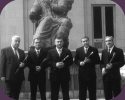

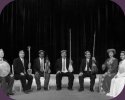
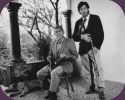
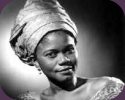
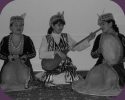
Sound Cosmos World Music
In 2005, the concert series Sound Cosmos World Music starts into its fourth year!!! The six concerts in January to June will present ensembles and musical traditions from really remote parts of the world:
January 27th
6 p.m.
Thomaskirche, Opphoferstraße 60
Vache Hovsepyan Duduk Quintet/Armenia
6 p.m.
Thomaskirche, Opphoferstraße 60
Vache Hovsepyan Duduk Quintet/Armenia
The ensemble Vache Hovsepyan Duduk was founded in 2000. The group's concert programme presents a wide variety of Armenian music styles. Pieces by well-known Armenian composers like Komitas, Kara-Murza and Margar Ekmalyan, but also contemporary songs will be played. The Duduk, a woodwind instrument similar to the oboe, may well be regarded as the most traditional instrument of Armenia, dating back between 3500 and 4000 years in musical history. It is handmade from apricot wood. Only few musicians are acquainted with the art of playing it. The instrument has a range of 1 ½ octaves and requires a great subtlety of feeling along with an elaborate breathing and lip technique to produce the broad range of melodies and long continued notes. The Duduk is said to mirror in its sound and tones the condition and moods of the mostly poor Armenian population. The warm tone colour is captivating and the melodies reach the audience's hearts.
February 17th
6 p.m.
Alte Kirche Wupperfeld, Bredde 69
Geoff Muldauer/USA Folk and blues from the American East Coast
6 p.m.
Alte Kirche Wupperfeld, Bredde 69
Geoff Muldauer/USA Folk and blues from the American East Coast
Geoff Muldauer is one of the great voices of the folk and blues scene on the American East Coast, where in the early 1960s, around the centres of Cambridge, Massachusetts and Woodstock, New York, a scene emerged which was to give persistent impulses to American music in general. Among others, Bob Dylan and Joan Baez, two influential voices of the American civil rights and protest movement, found their artistic home here. From the living rooms and coffe houses of this scene, a folk and blues repertoire was taken out into the world which even today still conveys magic and meaning. The great art of Geoff Muldaur is to create deep, intense music in a way that connects to the origins and yet presents itself almost with lightness. On soft feet, with gentleness and dignity. Muldaur is not a copyist of African American originals, though, but in the context of his range of repertoire and with the potential of his voice and guitar skills creates a music distinctly his own.
March 24th
6 p.m.
Lutherstift, Schusterstraße 15
Sanam Uighur Ensemble/Uzbekistan
6 p.m.
Lutherstift, Schusterstraße 15
Sanam Uighur Ensemble/Uzbekistan
The Uighurs are a large tribe of Turkoman origin, the majority of whom presently live in China and Turkmenistan. Yet, their descendants can also be found in Kazakhstan, Uzbekistan and Kirghizia, to which countries they immigrated during the Soviet era. Their music is rich and remarkable, rooted in the radiant past of the country and its power in culture and trade. This music combines all aspects and forms of eastern music, from the nouba of Andalusian Arabs to Chinese harmonies. Specific music from the Uighur Diaspora of Uzbekistan has only been presented abroad quite rarely up to now. The particular sounds of various quite different types of long neck lute and violin, plucked, struck or bowed, accompanied by percussion and vocals, invariably fills the audience with enthusiasm.
April 14th
6 p.m.
Thomaskirche, Opphoferstraße 60
Familia Pillco/Cuzco Violin and harp music from the Peruvian Andes
6 p.m.
Thomaskirche, Opphoferstraße 60
Familia Pillco/Cuzco Violin and harp music from the Peruvian Andes
Cuzco in Peru not only used to be the Inca capital, but after years of enraged combat between Pizzaro and the Inca army brought forth a second culture: that of the mestizos, a mixed race of half Spanish, half native origin, that influenced not only the language and the kitchen, but also the music. The two violins of Reynaldo Pillco, the father, and his son Enrique, join Alejandro Huaman Quispe's harp in playing wonderful melodies from the Andes - lively sailors' dances, melancholy Yaravis, cheerful Huayanos - popular music by Latin America's Bachs and Schuberts.
May 26th
6 p.m.
Alte Kirche Wupperfeld, Bredde 69
Nahawa Doumbia/Mali
6 p.m.
Alte Kirche Wupperfeld, Bredde 69
Nahawa Doumbia/Mali
Nahawa Doumbia is one of the most popular female singers of the region Wassoulou in the south of Mali - a region which for generations has been known to bring forth the country's best singers, such as Oumou Sangare, Sali Sidibe or Dieneba Diakité. In her lyrics, Nahawa Doumbia particularly addresses the younger generation of Western Africa. Her music is an amalgamation of tradition and the modern. She sings about love and life, but also about important political topics such as corruption and the position of women in the Muslim-oriented West African society. Her voice seems to hover in the didadi, a cheerful dancing rhythm from her home Wassoulou. She is accompanied by traditional instruments like bala, kamele ngoni, acoustic guitar and percussion.
June 9th
6 p.m.
Lutherstift, Schusterstraße 15
Women Minnesingers and bards from Central Asia
6 p.m.
Lutherstift, Schusterstraße 15
Women Minnesingers and bards from Central Asia
The peoples of Central Asia share a history of nomadism. Their languages all belong to the Turkic family. The customs and traditions, but also the musical cultures of these peoples all show a close similarity and up to the present day preserved more of the Turkoman than of other Asian roots. Bards are typical representatives of nomadic cultures, who travel through the country, collect stories among the people and go on to spread them. They present these stories in the form of epic and lyric songs, accompanying themselves on small, lightweight instruments such as lutes (dutâr, dombra, komuz) and violins (gijak, kemenche). The women play a predominant role in this. Our programme of women bards and Minnesingers from central Asia presents two different musical traditions: the rural-nomadic and the urban-classical tradition. The female musicians are among the best of their kind. They come from three different parts of central Asia. Their repertoire is strictly female.